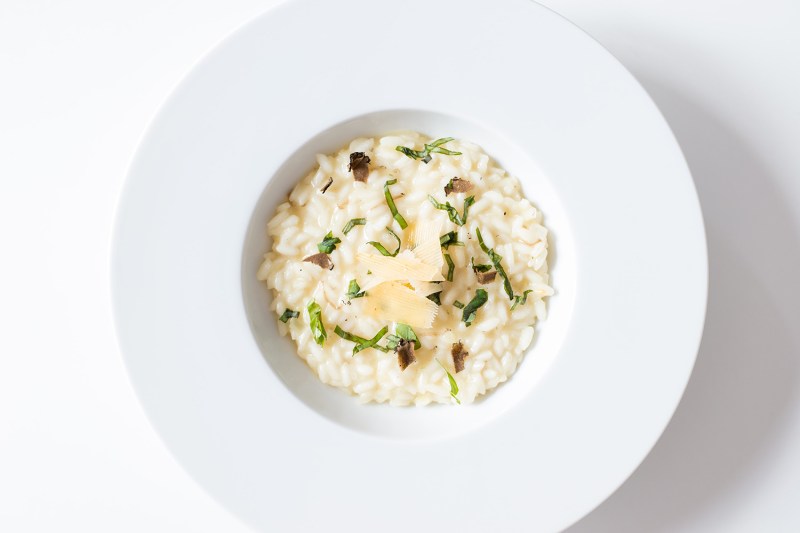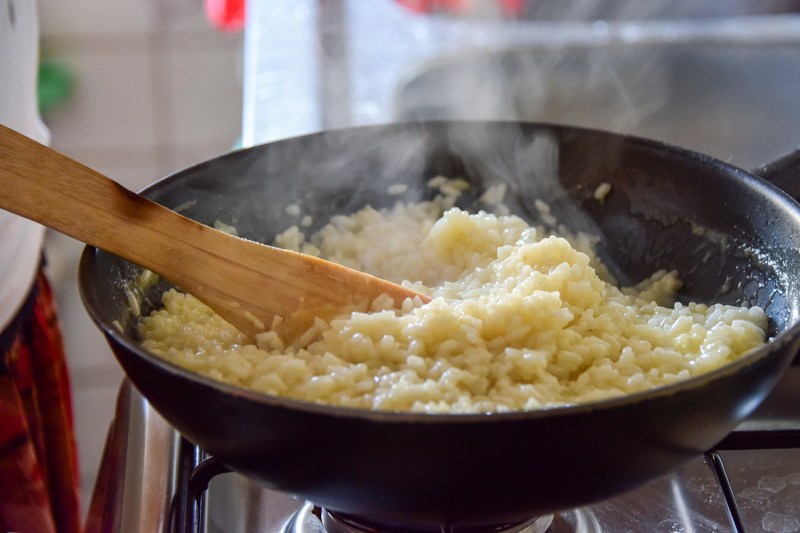If you’re an avid viewer of cooking shows like Chopped and Top Chef, then you’re well aware of the inevitable Achilles heel of many a chef-testant: the dreaded risotto. The constant snafus and struggles surrounding this classic Italian rice dish seem befuddling to those of us who aren’t professionally trained chefs; isn’t risotto just … rice? Why — and how — do skilled kitchen pros keep screwing it up so badly on TV? Is it even worth trying to make it at home as an amateur cook, when trained chefs can’t nail the recipe with any consistency?
We felt compelled to get answers to these irksome questions, so we consulted a group of chefs who make risotto on a regular basis and we happily discovered that no, risotto isn’t in fact an impossible dish to prepare well. However, a great risotto does require some know-how and practice, and our chef sources offered up 5 tips for those brave enough to give this notorious meal the old college (or, rather, culinary-school) try.
A successful risotto only requires broth and rice.
It’s common to see a TV contestant trying to get really “creative” with risotto, throwing in any number of extra ingredients and flavor boosters, all in a frantic attempt to make the dish “their own.” But here’s the thing about risotto: The simpler the recipe, the higher the success rate.
While it’s certainly possible for a skilled chef to tweak the classic risotto formula and create something truly delicious, there’s no need to gild the lily. “While many [risotto recipes] have added cream or cheese, you can achieve creamy risotto with just broth and rice,” explains chef/owner Jessica Formicola of Savory Experiments.

When making risotto, stick to Italian short-grain rice.
The sumptuous texture of a properly made risotto relies on the style of rice used to make the dish. Specifically, you want short-grained rice (so longer-grained versions like basmati and jasmine won’t work here), and you want to cook rice with a high starch content. The easiest way to find all of these characteristics (and to stay consistent with risotto’s geographic heritage) involves focusing entirely on Italian short-grain rice.
Chef/owner Marco Perocco of Marco’s Kitchen cooking school in Northern Italy recommends two rice types in particular: “The best [rice for risotto] is Carnaroli, and the second choice, with very similar results, is Arborio. Forget the other ones.”
Precise timing is essential for risotto.
Risotto isn’t a complicated dish, but it’s unquestionably high-maintenance. Nothing affects the quality of a risotto more significantly than patience (or a lack thereof). “Risotto is a dish that needs a lot of attention; it cannot be overcooked, otherwise the rice will get soggy, and it can’t be undercooked, because then the rice will be too hard,” says executive chef Ivo D’Aguiar of Luna Park in Miami. Since, as D’Aguiar says, Chopped chefs have to be quick,” risotto often falls short of judge expectations when a tenacious chef decides to give it a shot in 30 minutes or less.
Pay close attention to the texture of your risotto.
The texture of a risotto proves just as important as its flavor, and in order to achieve that perfectly smooth and rich mouthfeel, you need to be willing to put in some serious effort.
“I think the most common mistake and misconception with risotto is that it’s hard to make. That’s false. It just requires a little more patience. It’s rice with flavorful cooking liquid that requires near-constant stirring. What I believe people get wrong is knowing exactly when risotto has finished cooking and has reached the desired consistency. If you think al dente for pasta, then you want risotto to be slightly past that. [Also], for consistency, risotto should never be able to “pile up” or stay still. Risotto should slowly ‘ooze’ or cascade into an almost-flat pool without liquid running from the rice itself. Risotto is stirred so frequently for this purpose; [the stirring] activates the starches more, kind of like working flour-based dough to build gluten,” executive chef Jordan Moore of Handcraft Kitchen & Cocktails in Mount Pleasant, SC tells us.

Cook your add-ins before mixing them into the risotto.
After you’ve achieved a beautiful risotto texture and flavor blend, you can (and should) feel free to add mix-in ingredients to suit your personal tastes. However, be sure to follow Formicola’s advice and “cook your add-in [ingredients] before you start the rice and then set them aside, tossing them back in when you are ready to serve. Many items you’d toss in, like mushrooms, will lose all body if cooked for a full 45 minutes to an hour.”
This fundamental risotto recipe captures the dish’s immense appeal, but is simple enough for first-time risotto makers:
Risotto allo Zafferano Recipe
(By Amy Riolo, chef, Casa Italiana Language School, Washington, D.C.)
As a chef working at a language institute focusing on Italian, Amy Riolo cherishes risotto’s significance in the Italian culinary canon, particularly its significance in northern Italy. “Risotto was once enjoyed only in the northern regions of Italy where rice grew. But thanks to the unification of Italy in the 19th century, the increased modes of transportation, as well as the expat community that introduced it to the rest of the world, risotto is now considered a mainstream “Italian” food,” Riolo explains. Her recipe hails from the northern city of Milan, where risotto traditionally includes the fragrant and brightly colored spice known as saffron.
Ingredients:
- 6 to 8 cups chicken stock, heated
- 5 tbsp unsalted butter, divided
- 1 medium onion, finely chopped
- 2.5 cups Arborio rice
- 1 cup white wine
- .25 tsp saffron
- .5 cup freshly-grated Parmigiano Reggiano cheese
Method:
- Melt 4 tablespoons butter in a large saucepan over medium high heat. When butter foams, add onion, and cook on low until soft.
- Stir in Arborio rice and cook until coated with butter. Add the wine, stir, and increase the heat to high. Stir until wine has evaporated. Stir in the saffron.
- Add a ladle full of stock and stir continuously from the outside to the inside of the pot, without lifting up the spoon. Cook until the stock has evaporated. Continue adding stock one ladle at a time, cooking and stirring over medium heat until most of stock is used and the rice has an “al dente” consistency.
- When the rice has reached an “al dente” consistency and there is still enough liquid in it to “move like a wave” when you shake the sides of the pot back and forth on the burner, remove from heat and stir in the Parmigiano Reggiano and the remaining one tablespoon of butter. Serve immediately.
Editors' Recommendations
- How to make the perfect carnitas, according to a chef
- The grasshopper drink is a retro blast from the past — this is how to make it
- How to make sweet and crispy Hawaiian fried chicken
- How to make peri peri chicken, a South African BBQ classic
- How to make Ranch Water the right way


